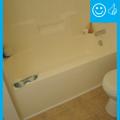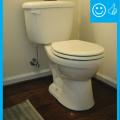Scope
Avoid installing carpet in areas within the home that are likely to become wet.
Install only water-resistant hard-surface flooring in kitchens, bathrooms, entryways, laundry areas, and utility rooms.
See the Compliance Tab for links to related codes and standards and voluntary federal energy-efficiency program requirements.
Description
Water splashing or spraying out of sinks and tubs; rain and snowed tracked in on wet shoes; and water vapor in the air from cooking, laundry, and bathing – all contribute to wet floor surfaces. When the floor surface is covered with carpet, it can take longer for the moisture to evaporate, leading to mold and mildew problems. Carpet can also hide water leaks and spills that may result in warping, swelling, and rotting of the subfloor. To minimize the opportunity for mold growth and structural damage, carpet should not be installed in rooms where floors are likely to get wet such as bathrooms, kitchens, entry ways, laundry rooms, or utility rooms. Instead water-resistant hard-surface flooring should be installed in these areas.
The design and construction of bathrooms and other wet areas of the home should be part of a comprehensive water management strategy that includes the following:
- hard surface flooring
- properly installed shower and tub enclosures, as described in the Building America Solution Center guides Cement Board Installed behind Tile and Panel Tub and Shower Enclosures and Walls Behind Showers and Tubs.
- a mechanical exhaust system, such as those as described in the Solution Center guides Bathroom Exhaust Fans, Kitchen Exhaust Fans, and Whole-Building Delivered Ventilation.
- paints and wall finishes specifically designed to handle high moisture levels.
See the ENERGY STAR Water Management System Builder Checklist for additional guides to help you design and construct a home with reduced risk of water damage.

Several hard-surface flooring products are appropriate for areas of the home that are likely to get wet – ceramic tile, stone, and vinyl flooring are all good choices.
The following flooring materials are hard surface but are not recommended for areas prone to water spills.
- Hardwood flooring. Although usually sealed and water proofed, hardwood flooring is not generally rated for excessive and repeated exposure to water.
- Laminate flooring. Laminate flooring is made from either melamine resin or linseed oil and wood chips. Although laminate flooring can tolerate some exposure to water, excessive saturation, spills, or standing water can cause the planks to swell and buckle.
- Bamboo, cork, and alternative flooring options. Other types of modern sustainable flooring options such as bamboo and cork are not appropriate for wet areas as they will warp, swell, and wear poorly when exposed to the amount of water expected in a bathroom or kitchen.
Due to the amount of water that can be introduced into the home from showers, tubs, and toilets, consider designing and building the bathroom, the laundry room, and/or the kitchen as a true “wet room” as described below (BSC 2009). A designed wet room is built to contain and remove excessive water, keeping it from entering other parts of the house.
How to Select Water-Compatible Flooring
- Select appropriate flooring materials for wet areas including bathrooms, kitchens, entryways, laundry rooms, and utility rooms (EPA 2012):
- Ceramic tile. Ceramic tile is a clay-based material that is kiln dried and installed in mortar or thin set over a cement backer-board. Once installed, the tiles are treated with a water-resistant finish that protects the floor and subfloor. Relative to other flooring types, ceramic tile is moderately priced.
- Stone. Stone is a natural product that is installed like ceramic tile over a cement backer-board in thin set. Natural stone can be marble, granite, travertine, or terrazzo and must also be treated with a waterproof coating. Stone is the most expensive flooring option.
- Vinyl flooring. Vinyl flooring comes in rolls, planks, and tiles, and is composed of polyvinyl chloride (PVC) resin along with additives such as plasticizers, stabilizers, pigments, and fillers (EPA 2012). Vinyl flooring is relatively inexpensive compared to ceramic tile and stone flooring. When properly installed, vinyl flooring provides a waterproof barrier between the bathroom and subfloor. Sheet vinyl flooring that comes in rolls is typically installed using an adhesive that is painted or sprayed directly on the subfloor, although heavier varieties may be installed as non-glued or "floating floor" products. Vinyl planks and tiles may be designed with a tongue-and-groove connecting system that also produces a floating (non-glued) surface. If choosing click-together vinyl plank or tiles, look for products that are reported to have water-tight seams. Vinyl planks and tiles are also available with a self-adhesive peel-and-stick backing material; these products may not hold up as well to repeated saturations.
- Sealed concrete flooring. When sealed, concrete provides a non-pervious, water-resistant surface that is ideal for wet areas. Concrete’s thermal mass lends itself to radiant floor heating. Clear chemical sealants must be reapplied every 1 to 2 years. The sealant can contain particles to provide traction on wet floors.

How to Design a “Wet Room” (BSC 2009)
- Install a water-resistant flooring material (as listed above and according to manufacturer’s specifications) that extends wall to wall and is continuous under fixtures and cabinets.
- Eliminate unnecessary penetrations through the floor. Caulk and seal carefully around any necessary plumbing pipe penetrations.
- Install water-resistant baseboard material that is sealed to the floor or install floor material that is turned up at the walls and sealed at the corners.
- Install a floor drain that is properly attached to the home’s sewer system.
- Install a raised sill at doorways to contain any excess water that may flow toward the rest of the home.
- Use non-paper-faced drywall and install the drywall at least ½-inch above the finished floor to reduce the chance of wall materials coming into contact with water and to facilitate drying of wall cavities.
Success
Avoid installing carpet in areas that routinely get wet or have an increased likelihood of getting wet such as bathrooms, kitchens, entryways, laundry areas, and utility rooms.
When designing and building the home, employ a comprehensive water management strategy.
Climate
Cold Climates
In regions with high snow load, entryways can be protected by roofs and garages can be connected to the home through "mudroom" entryways with hard surfaces that are easy to mop. This can help decrease the amount of snow tracked onto carpets, thereby reducing the amount of moisture and moisture vapor in the home, which can help to reduce mold risk inside the home.
Areas Prone to Flooding
In areas prone to flooding, first-floor flooring should be surfaced with easy-to-clean, water-resistant materials like linoleum, vinyl, tile, and sealed concrete. See the article Insight Rebuilding Houston “Wash and Wear Buildings” by Building Science Corporation and the articles Home Flood Recovery - Do More Than Restore, Wet Floodproofing, and Resilient Home Solutions by LSU AgCenter,
Training
Compliance
Retrofit
Avoid installing carpet in areas within the home that are likely to become wet such as the kitchen, bathrooms, entryway, laundry, and utility rooms. If these rooms are currently carpeted consider replacing the carpet with hard surface flooring. See the scope and description tab of this guide to learn more about why, where, and how to achieve this detail.
More
More Info.
Access to some references may require purchase from the publisher. While we continually update our database, links may have changed since posting. Please contact our webmaster if you find broken links.
The following authors and organizations contributed to the content in this Guide.




